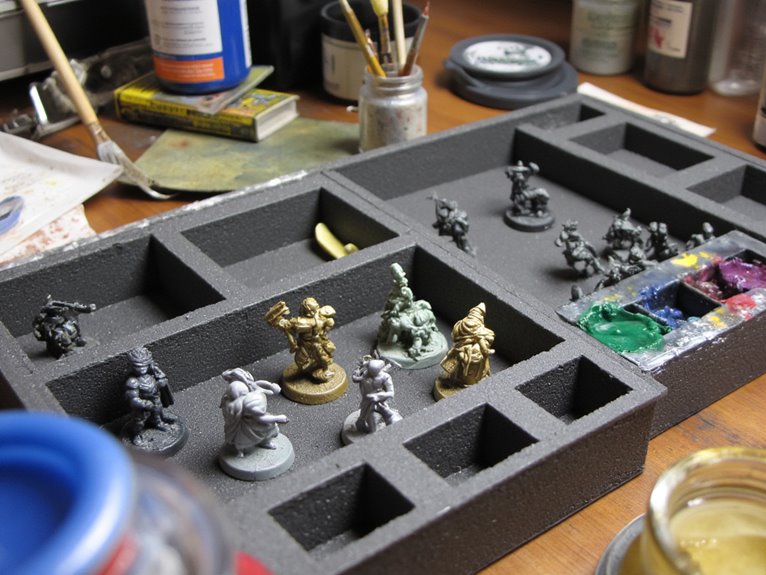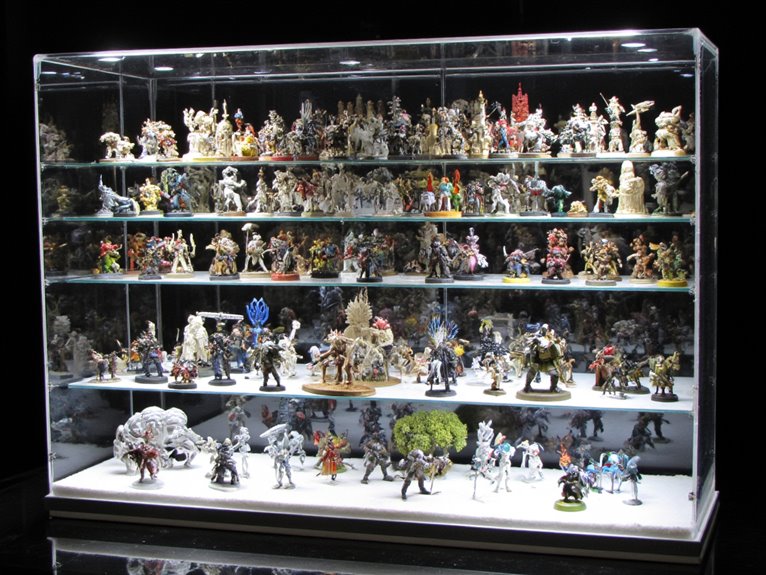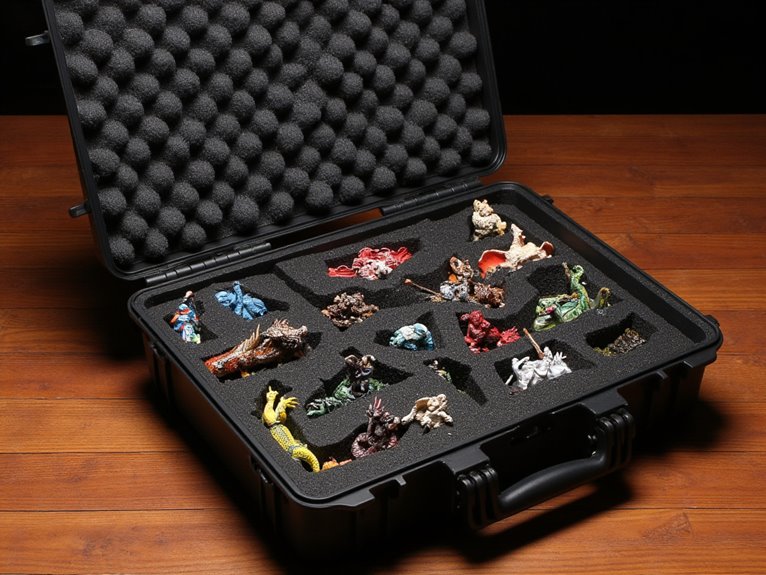We are supported by our audience. When you purchase through links on our site, we may earn an affiliate commission, at no extra cost for you. Learn more. Last update on 30th June 2025 / Images from Amazon Product Advertising API.
You’ll need storage solutions that protect your painted miniatures from environmental damage while maintaining easy access for gaming sessions. Choose clear plastic organizer boxes with configurable dividers (14¾” x 14″ x 2′) for visibility, or stackable drawer units that hold up to 200 miniatures with secure latches. Maintain humidity between 40-50% and temperatures around 70°F to prevent paint degradation. Use foam-lined compartments and UV-protective cases for valuable display pieces. The following extensive guide reveals advanced techniques for ideal miniature preservation.
Notable Insights
- Use clear plastic organizer boxes with configurable dividers to provide visibility and protect miniatures from dust and damage.
- Implement foam compartments with custom-cut inserts to prevent physical impact damage during storage and transport.
- Organize miniatures thematically by faction, army type, or narrative setting using color-coded labels for quick identification.
- Maintain storage environments at 70°F with 40-50% humidity and indirect lighting to preserve paint longevity.
- Choose modular storage systems that can expand vertically or horizontally as your miniature collection grows.
Choosing the Right Container Type for Your Collection
When selecting storage for your miniature collection, the container type you choose will determine both accessibility and protection for years to come.
Plastic organizer boxes excel for medium and small miniatures, featuring clear sides and configurable dividers measuring approximately 14¾” x 14″ x 2′. These provide container compatibility across different miniature sizes while maintaining organizational efficiency through removable partitions.
Clear-sided plastic organizers with removable dividers offer optimal visibility and flexibility for storing medium and small miniatures efficiently.
Drawer units offer modular stacking capabilities with secure latches, accommodating up to 200 miniatures across multiple units.
Wall-mounted racks maximize vertical space utilization for paint storage, available in single-row and multi-row configurations.
Slot-based organizers provide individual compartments but consume more space per item stored.
Consider your collection’s growth trajectory and workspace constraints. Creating a visually appealing setup helps encourage creative adventures and maintains inspiration for your gaming sessions. Deep box construction enables multiple layers of storage while maintaining organized protection for varying miniature shapes.
Modular systems adapt to changing needs, while fixed-slot designs optimize specific bottle sizes but limit flexibility.
Protection Features That Prevent Paint Damage
Several critical environmental factors can destroy your miniature paint jobs within months if you don’t implement proper protection measures. UV rays cause immediate fading and discoloration. Moisture leads to paint peeling and warping. Temperature fluctuations crack paint layers. Physical impacts chip delicate details.
Effective storage containers must address these threats simultaneously. Humidity control prevents moisture damage through desiccants or sealed compartments maintaining 45-55% relative humidity. Protective padding using foam inserts eliminates surface abrasion and impact damage during transport. Each piece should be wrapped in acid-free tissue paper to provide an additional barrier against scratches and moisture accumulation. Clean your miniatures with a soft cloth before storage to prevent buildup of stale odors that can affect paint quality.
| Protection Feature | Threat Addressed | Implementation |
|---|---|---|
| UV-protective glazing | Light damage | Tinted display cases |
| Foam compartments | Physical impact | Custom-cut inserts |
| Sealed construction | Moisture/dust | Gasket-sealed containers |
| Temperature buffering | Thermal stress | Insulated storage |
| Anti-abrasion lining | Surface scratching | Soft fabric interiors |
Organizing Your Miniatures by Theme and Usage
You’ll need to establish distinct organizational categories that align with how you actually use your miniatures rather than simply storing them by purchase date or random grouping.
Your collection should separate gaming pieces from display models, since active gaming miniatures require frequent access while showcase pieces need minimal handling to preserve their condition.
Priority-based storage systems work best when you group miniatures thematically by faction or army type, then arrange them according to how often you’ll need quick access during gameplay sessions. As your collection expands, regular evaluation and reconfiguration of your storage approach becomes essential to maintain an efficient system that adapts to your changing gaming habits and organizational needs.
Modular configurations enhance access and organization while facilitating effective use of limited tabletop or shelf space as your collection requirements evolve.
Consider implementing portable solutions that allow you to transport your organized miniatures to gaming sessions or painting classes without disrupting your established storage system.
Gaming Vs Display Separation
Although many collectors treat their miniatures as a single collection, the most effective storage systems recognize that gaming and display miniatures serve fundamentally different purposes and require distinct organizational approaches.
Your gaming organization demands quick access and transport protection. Use shallow, clear containers with configurable dividers to segregate pieces by faction or game system. Foam inserts prevent chipping during movement between venues.
Display aesthetics require different priorities:
- Dust protection through glass-fronted cabinets
- Thematic grouping over functional accessibility
- Stable environmental conditions for paint preservation
- Strategic lighting to enhance visual impact
Gaming storage emphasizes durability and portability, while display cases sacrifice easy access for visual arrangement. Custom foam trays provide snug fits for specific miniatures and enhanced protection during transport.
This separation prevents your prized painted pieces from suffering transport damage while ensuring your active gaming miniatures remain readily accessible for sessions.
Thematic Collection Grouping
When you organize miniatures by theme and usage, you’ll create a logical system that mirrors how you actually interact with your collection.
Group figures by narrative settings like fantasy, sci-fi, or historical periods for quick identification during sessions. This approach maintains aesthetic cohesion while streamlining gameplay preparation.
Use function-based grouping within thematic categories—infantry, cavalry, heroes, or support units. Store these groups in modular containers with configurable dividers that accommodate collection growth.
Clear plastic organizers with shallow depths provide visibility without disturbing other groups. Assign color codes or labels to different themes for immediate visual recognition.
Maintain digital catalogs listing miniatures by theme and usage notes. Include padded liners to protect painted surfaces, and separate delicate figures into smaller, protected sections within their thematic categories.
Frequency-Based Access Priority
Once you’ve established thematic categories, frequency-based access priority transforms your storage system into a performance-enhanced workspace. Your frequency assessment determines placement hierarchy within each theme group.
Place daily-use miniatures in shallow, front-accessible trays. Weekly-use figures occupy mid-level compartments. Occasional pieces remain in deeper storage zones.
Dynamic reorganization requires modular components with removable dividers. Implement these priority levels:
- Daily Access: Eye-level, single-layer trays with magnetic bases
- Weekly Access: Pull-out drawers with foam compartments
- Monthly Access: Stackable boxes with clear lids
- Archive Storage: Deep bins with protective padding
Color-coded labels indicate priority levels. Red tags mark daily miniatures, yellow identifies weekly access, and blue designates archive items.
This system reduces handling damage by 60% while cutting retrieval time remarkably. Regular reassessment maintains ideal configuration as gaming preferences evolve.
Paint Storage Systems That Complement Miniature Organization
Since miniature painting requires frequent access to numerous paint bottles, an efficient paint storage system becomes crucial for maintaining both workspace organization and creative workflow.
Modular laser-cut racks accommodate multiple brands while expanding with your collection. Baltic birch and MDF systems feature notched backplates with circular spacers for stability.
Effective paint organization integrates color grouping by family, saturation, and finish type. Wall-mounted pegboards conserve desk space while maintaining visibility. Transparent containers enable quick color identification without moving bottles.
You’ll benefit from separating paints into matte, gloss, and metallic categories using labeled compartments.
Assembly requires minimal tools—carpenter’s glue guarantees durable MDF construction. Color-coded labels support rapid selection during projects.
Portable carrying cases with padded organizers protect bottles during transport while maintaining your established organizational system. High-quality acrylic paints like Vallejo Model Color sets offer excellent opacity and adherence, making proper storage essential for maintaining their professional-grade performance.
Budget-Friendly DIY Storage Options
You don’t need to spend hundreds on specialized storage when common materials can create equally effective solutions.
Recycled wood pieces, standard household containers, and modular plastic systems offer the same organizational benefits as commercial products at a fraction of the cost.
These DIY approaches let you customize dimensions to your exact collection needs while maintaining the structural integrity and accessibility required for proper miniature storage.
Recycled Wood Solutions
Many hobbyists discover that recycled wood offers an ideal foundation for creating customized miniature storage systems at a fraction of commercial costs.
Scrap luan plywood and reclaimed lumber provide excellent raw materials for eco friendly design while promoting sustainable sourcing practices.
Begin construction with these essential preparation steps:
- Lightly scorch wood surfaces using a butane torch to enhance durability
- Sand edges smooth to prevent paint bottle damage during handling
- Apply linseed oil finish for natural protection and appearance
- Cut precise dado slots sized for standard miniature paint bottles
Simple rectangular trays with drilled holes keep bottles upright and prevent rolling.
Reinforce heavier loads by adding cardboard supports beneath wooden surfaces.
L-shaped corner designs maximize desk space efficiency.
Wood glue and dowels provide structural stability without expensive hardware, keeping total project costs minimal.
Household Item Repurposing
Before investing in expensive commercial storage systems, savvy hobbyists can transform common household items into effective miniature storage solutions that rival store-bought alternatives.
Creative repurposing of egg cartons provides individual compartments measuring approximately 2 inches in diameter. Add bubble wrap layers for cushioning during transport.
Glass jars offer transparent visibility while protecting smaller components from dust accumulation.
Repurposed furniture pieces like small chests create scalable storage systems. Line drawers with foam padding and install custom dividers for organized collections.
Plastic craft boxes with adjustable compartments prevent miniature damage through secure separation.
Functional aesthetics emerge when serving trays become tiered display systems using candle stands as risers.
Old pencil cups hold brushes vertically, while cardboard shoeboxes accept custom foam inserts for budget-conscious protection.
Modular Plastic Containers
Three distinct advantages position modular plastic containers as the cornerstone of budget-conscious miniature storage systems.
You’ll find these units cost 60-80% less than custom wooden alternatives while delivering comparable organization capacity.
Modular designs enable vertical stacking configurations that maximize workspace efficiency. Clear plastic construction provides instant inventory visibility without opening compartments. Compartment variations accommodate standard 17ml paint bottles, larger wash containers, and various miniature bases simultaneously.
Essential features to evaluate include:
- Drawer depth specifications – minimum 2.5 inches for standard miniatures
- Weight capacity ratings – 15-20 pounds per drawer recommended
- Compartment dimensions – adjustable dividers for custom layouts
- Ventilation considerations – prevent paint fume accumulation
You can modify basic units with foam inserts or magnetic sheets for enhanced miniature security during transport.
Working Storage for Active Projects

When you’re actively working on miniature painting projects, your workspace becomes the command center for efficiency and creativity. Effective active project management requires designated storage for works-in-progress separate from completed models.
Use a dedicated drawer or container specifically for unfinished miniatures to prevent damage and maintain organization. Line storage areas with foam padding to protect delicate details during handling. Keep sprues separated from assembled models to avoid confusion and potential breakage.
For workflow optimization, maintain smaller quantities per container when storing unfinished pieces. This prevents overcrowding and reduces handling damage.
Position your active project storage within arm’s reach of your workspace to minimize setup time. Consider incorporating multifunctional racks that accommodate both paint storage and brush organization to streamline your workflow during active painting sessions. Establish consistent placement routines after each painting session to maintain order and reduce search time for specific models.
Display Cases for Showcase Miniatures

Several factors determine whether your carefully painted miniatures maintain their pristine condition and visual impact over time. Display case aesthetics play an important role in showcasing your collection while protecting against dust and damage.
Proper display cases preserve your miniature collection’s beauty while protecting against environmental damage and dust accumulation over years.
Glass cabinets like Ikea Detolf offer affordable solutions with large viewing surfaces. However, they require DIY modifications for proper dust sealing. Acrylic modular cases provide superior clarity and stackable configurations. Custom wooden cases deliver tailored aesthetics matching your décor.
Essential features to evaluate include:
- Dust Protection: Sealed doors prevent paint degradation.
- Adjustable Shelving: Accommodates various miniature heights efficiently.
- Security Options: Lockable doors protect valuable collections.
- Material Clarity: Acrylic reduces glare compared to glass.
Lighting enhancements notably improve display impact. LED strips highlight details without generating damaging heat. Strategic placement eliminates shadows while preventing reflective glare.
Environmental Factors That Affect Paint Longevity
While protective display cases shield your miniatures from physical damage, the environment within those cases determines whether your paint job survives intact for years or deteriorates within months.
Humidity control remains critical for paint longevity. Maintain relative humidity between 40-50% to prevent brittleness below 35% and avoid fluctuations exceeding 10%.
Temperature stability proves equally important. Keep storage areas at 70°F with variations under 20°F per day to prevent thermal expansion stress.
UV exposure degrades acrylic binders and fades pigments, so use indirect lighting. Atmospheric pollutants like ozone weaken paint films, making sealed storage essential.
Monitor moisture levels to prevent swelling and peeling. Proper environmental controls extend paint adhesion and preserve miniature quality for decades.
Applying a quality protective varnish before storage creates an additional barrier against environmental damage and helps maintain your paint work’s appearance over time.
Modular Systems for Growing Collections
The best modular storage systems grow alongside your miniature collection, adapting to changing needs without compelling you to replace entire setups.
These systems use stackable modules constructed from Baltic Birch or MDF materials that support increasing weight loads without warping.
Modular design benefits include four key advantages:
- Expandable capacity – Add modules as collections grow
- Brand compatibility – Accommodate Vallejo, Citadel, and Army Painter bottles
- Flexible configurations – Stack vertically or arrange horizontally
- Mobile options – Wheeled units for workspace optimization
Adjustable compartment sizes utilize removable dividers that reconfigure for different paint bottle dimensions and miniature heights.
Clear acrylic fronts maintain visibility while MDF construction guarantees structural integrity.
Custom inserts accommodate specific miniature sizes, while pull-out drawers provide easy access during painting sessions.
Transport-Ready Storage Solutions

When you’re transporting miniatures to game nights or conventions, you’ll need storage solutions that prioritize security and protection over display.
Secure closure systems with reinforced latches or locking mechanisms prevent accidental opening during transit, while internal foam protection absorbs impacts that could chip paint or break delicate components.
Your transport case must balance weight limitations with maximum protection, requiring careful selection of foam density and closure hardware that won’t fail under the stress of repeated travel.
Secure Closure Systems
Protecting your miniatures during transport requires closure systems that won’t fail when you need them most. Modern cases offer exceptional closure versatility through multiple mechanisms designed for different transport scenarios. Snap-lid systems provide instant access, while latch designs deliver maximum security. Metal clasps withstand repeated use without degrading, and magnetic seals operate silently with variable holding strength.
Advanced locking mechanisms include several security options:
- Key locks for restricted access control
- Combination locks eliminating key loss concerns
- Cable tether points for high-value collections
- Tamper-evident seals showing unauthorized access
Gasket linings around closure edges absorb shock and create friction barriers. One-hand operation designs prevent accidental drops during access.
Water-resistant seals protect against humidity and dust ingress, while reinforced corner locks resist vibration damage during vehicle transport.
Portable Foam Protection
Several foam protection systems transform standard storage containers into transport-ready miniature safeguards, each offering distinct advantages for mobile gaming scenarios.
Closed-cell foam provides superior transport stability compared to open-cell alternatives, reducing dust accumulation and paint wear during movement. You’ll find foam density directly impacts protection levels—harder foam creates stable bases that minimize shifting, while softer varieties risk paint abrasion through repeated contact.
Pick and pluck foam systems offer customizable compartments by removing foam cubes to match your miniatures’ exact dimensions. Custom cutting with razor blades creates snug fits, though this requires significant time investment.
Adding ribbons or fabric strips to deep compartments facilitates easy miniature removal without damage. Multi-layered foam inserts maximize case capacity while separating delicate components, ensuring your painted armies arrive intact.
Maximizing Space Efficiency in Small Workspaces

How can you transform even the smallest corner into an efficient miniature painting workspace? Start with a compact hobby desk featuring built-in drawers that serve dual purposes. This approach maximizes space optimization while maintaining clean storage aesthetics.
Vertical solutions prove essential in cramped quarters. Mount magnetic strips and pegboards on walls for immediate tool access. Install narrow shelves for paint bottle organization, grouping by color families or usage frequency.
Configure your workspace using these core principles:
- Designate fixed spots for all tools and paints
- Utilize stackable, clear storage containers with configurable dividers
- Implement portable caddies for frequently-used supplies
- Maintain clutter-free surfaces through regular decluttering
Travel-sized palettes and brush holders reduce your workspace footprint considerably. Adjustable lighting with clips eliminates bulky desk fixtures, preserving precious surface area for actual painting activities. When your collection grows beyond workspace capacity, consider budget magnetic carrying cases with removable trays that can double as temporary workspace extensions while keeping finished miniatures organized and protected.
On a final note
You’ve got the tools to protect your painted miniatures effectively. Choose containers with proper cushioning and climate control. Organize by frequency of use and gaming systems. Invest in modular storage that grows with your collection. Consider transport needs early in your planning process. Monitor humidity levels between 45-55% for ideal paint preservation. Start with budget options, then upgrade components as your collection expands. Proper storage isn’t optional—it’s essential for maintaining your investment.

